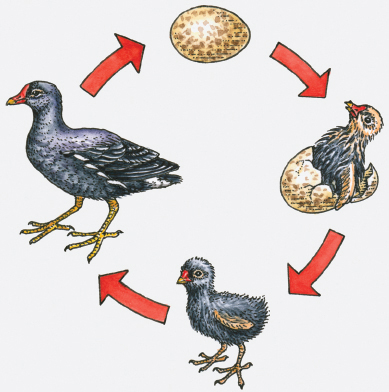Transitions
Chapter Opener
29
connect ideas
Transitions
What exactly makes words, sentences, and ideas flow from paragraph to paragraph as fluidly as Michael Phelps slipping through the water? Transitional words and phrases, many writers would reply — thinking of words such as and, but, however, neither . . . nor, first . . . second . . . third, and so on. Placed where readers need them, these connecting words make a paper read smoothly. But they are only part of the story.
Almost any successful piece of writing is held together by more devices than most writers can consciously juggle. A few of the ties — such as connections between pronouns and their referents —are almost invisible and seem to take care of themselves. Here are some guidelines for making smooth transitions between ideas in paragraphs and sections of your writing.

© Steve Terrill/Corbis.
Common Transitions
| Connection or Consequence | Contrast | Correlation | Sequence or Time | Indication |
| and | but | if . . . then | first . . . second | this |
| or | yet | either . . . or | and then | that |
| so | however | from . . . to | initially | there |
| therefore | nevertheless | subsequently | for instance | |
| moreover | on the contrary | before | for example | |
| consequently | despite | after | in this case | |
| hence | still | until | ||
| although | next | |||
| in conclusion |
Use appropriate transitional words and phrases. There’s nothing complicated or arcane about them: You’ll recognize every word in any list of transitions. But be aware that they have different functions and uses, with subtle distinctions even between words as close in meaning as but and yet.
Transitional words are often found at the beginnings of sentences and paragraphs simply because that’s the place where readers expect a little guidance. There are no rules, per se, for positioning transitions — though they can be set off from the rest of the sentence with commas.
Use the right word or phrase to show time or sequence. Readers often need specific words or phrases to help keep events in order. Such expressions can simply mark off stages: first, second, third. Or they might help readers keep track of more complicated passages of time.
Use sentence structure to connect ideas. When you build sentences with similar structures, readers will infer that the ideas in them are related. Devices you can use to make this kind of linkage include parallelism (parallelism) and repetition.
In the following example, the first three paragraphs of James P. Gannon’s “America’s Quiet Anger,” you can see both strategies at work, setting up an emotional argument that continues in this pattern for another three paragraphs. Parallel items are highlighted.
There is a quiet anger boiling in America.
It is the anger of millions of hardworking citizens who pay their bills, send in their income taxes, maintain their homes, and repay their mortgage loans — and see their government reward those who do not.
It is the anger of small town and Middle American folks who have never been to Manhattan, who put their savings in a community bank and borrow from a local credit union, who watch Washington lawmakers and presidents of both parties hand billions in taxpayer bailouts to the reckless Wall Street titans who brought down the economy in 2008.
— American Spectator, March 20, 2010
Pay attention to nouns and pronouns. Understated transitions in a piece can occur between pronouns and their antecedents, but make sure the relationships between the nouns and pronouns are clear. (help with common errors) And, fortunately, readers usually don’t mind encountering a pronoun over and over — except maybe I. Note how effortlessly Adam Nicolson moves between George Abbot, he, and man in the following paragraph from God’s Secretaries (2003), in which he describes one of the men responsible for the King James translation of the Bible:
George Abbot was perhaps the ugliest of them all, a morose, intemperate man, whose portraits exude a sullen rage. Even in death, he was portrayed on his tomb in Holy Trinity, Guilford, as a man of immense weight, with heavy, wrinkled brow and coldly open, staring eyes. He looks like a bruiser, a man of such conviction and seriousness that anyone would think twice about crossing him. What was it that made George Abbot so angry?
Use synonyms. Simply by repeating a noun from sentence to sentence, you make an obvious and logical connection within a paper — whether you are naming an object, an idea, or a person. To avoid monotony, vary terms you have to use frequently. But don’t strain with archaic or inappropriate synonyms that will distract the reader.
Note the sensible variants on the word trailer in the following paragraph.
Hype and hysteria have always been a part of movie advertising, but the frenzy of film trailers today follows a visual style first introduced by music videos in the 1980s. The quick cut is everything, accompanied by a deafening soundtrack. Next time you go to a film, study the three or four previews that precede the main feature. How are these teasers constructed? What are their common features? What emotions or reactions do they raise in you? What might trailers say about the expectations of audiences today?
Use physical devices for transitions. You know all the ways movies manage transitions between scenes, from quick cuts to various kinds of dissolves. Writing has fewer visual techniques to mark transitions, but they are important. Titles and headings in lab reports, for instance, let your reader know precisely when you are moving from “Methods” to “Results” to “Discussion.” In books, you’ll encounter chapter breaks as well as divisions within chapters, sometimes marked by asterisks or perhaps a blank space. Seeing these markers, readers expect that the narration is changing in some way. Even the numbers in a list or shaded boxes in a magazine can be effective transitional devices, moving readers from one place to another.
Read a draft aloud to locate weak transitions. The best way to test your transitions in a paper or project may be to listen to yourself. As you read, mark every point in the paper where you pause, stumble, or find yourself adding a transitional word or phrase not in the original text. Record even the smallest bobble because tiny slips have a way of cascading into bigger problems.

Simone End/Getty Images.